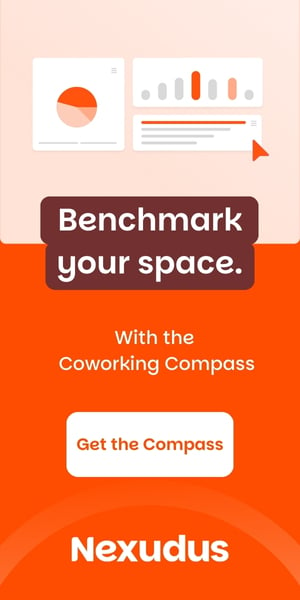- Providing five-star service is not the same as building a five-star community.
- Creating and handing out a member manual is not a good idea.
- The best place to connect and meet new people in a coworking space is in the kitchen.
Part 1 of 2
Community is what differentiates coworking spaces from other models of shared and serviced offices. Community also helps coworking operators build and retain a vibrant and collaborative member base.
Oftentimes, however, operators miss a great opportunity during the member onboarding process to plant the seeds of engagement that will help new members thrive in the space. Member onboarding is crucial, it can determine whether or not a new client will stick around for a long time.
A happy, satisfied and engaged member yields long term benefits for the operator, including greater retention, higher referrals and lower customer acquisition costs. And a pleasing atmosphere is good for everyone.
Much like the dropout rate of first-generation college students is correlated with whether they engage in the first couple months of their campus experience, so too is the likelihood that a member will depart if they don’t thrive socially in the space.
Though, as one coworking operator observed, “many members originally join for pragmatic reasons — treating it as office space. They realize the benefits of the community over time, if at all. In fact, whether members make that transition is the best indicator if they will be around for the long haul.”

We spoke with engagement consultant Joy Stephan, an expert in workplace strategy and organizational development, about how operators and community managers can leverage the onboarding experience to build a profitable center and thriving community.
Stephan is founder of 20Chairs, a consulting firm that works with commercial developers to create and sustain thriving communities. She suggests five do’s and don’ts to guide the process.
In part 2, we’ll cover ways members can make the most of their experience at a coworking community.
DO’S FOR THE OPERATOR
1.) Empathize with first-timers.
One of the biggest mistake operators make is to forget what it was like to be a newbie in a coworking space. They don’t realize how new coworking is for most people and how stressful it can be to adapt to this new kind of working environment.
Remember the first time you entered a coworking space and how you wanted to fit in and do things right. What did you wonder? What didn’t you understand? What were you curious about?
Recalling some of your own early questions and experience can prevent later frustration.
2.) Consider creating a new member cohort.
Inclusion is the first phase of any group development. There’s a reason college orientations break classes up into groups. Creating a community within a community eases acclimation into the larger setting while building lasting bonds.
Grouping each month’s new members together facilitates the orientation process and allows the group to make early connections that feel “safe.”
Additionally, when you introduce the new folks to veterans from earlier cohorts, you’re creating a sense of longevity and a connection to people who have been there for different periods of time.
Every so often during the first few weeks or months, you can touch base for an hour or so. In that time, new questions and concerns may have come up. That way you facilitate to people’s comfort over time. It can be short and sporadic and at any time of the day. It could be at a community-wide weekly brown bag lunch, or at the end of the day, followed by happy hour where all members are invited to meet the new cohort.
3.) Gamify the orientation experience.
Start with an ice-breaker question that everyone can relate to. Make mingling a challenge, such as “introduce yourself to five new members by Friday.”
Then prep the rest of the community to do their part: “Hey, guys, on Wednesday, the latest cohort is going out. You remember what it was like. Help them out. Take two minutes. Talk to them about X.”
Establish key milestones that make people feel like they know how the place works. It might be: “You will be fully initiated when you know how to make a cup of coffee, or when you know how to get into the bathroom, when you know how to use the access code.”
4.) Empower members to discover and solve on their own.
People are curious about their fellow members, but they don’t feel like they have a way to connect with them easily. They often need a nudge to take that leap. An opportunity to chat at an event, on the community roof deck, or picking up a CSA order can urge them to reach out.
Encourage members to ask questions to their peers, rather than going straight to the community manager.
Build role play into the onboarding process. Have them do a mock conversation with somebody who’s talking too loud on their phone. Have that difficult conversation with another member in a safe setting.
That way when the real conflict comes around, they won’t be like a deer in headlights. They won’t start side-talking to some third-party member about how awful somebody is.
Your job is not to be a conflict resolution specialist or a homeroom teacher. It’s to empower members to form their own relationships built on respect and to be autonomous and independent.
If you create an environment where they rely on you for more things, you’re always going to feel that you’re pulled in too many directions. If you give them the tools to work with, they’ll thrive on their own.
5.) Make it an invitation, not a request.
Coworking communities are different than corporate America. No one must do anything.
So, it’s never a “we need you to do this.” It’s always about curiosity and an invitation to participate.
It’s “we’re doing this. Would you like to join us?” and “we’re really excited to have you.”
Afterwards it’s “hey, thanks for coming,” or “we missed you at the event.”
When people know that their attendance will be missed, they’ll be more likely to show up and participate. It’s not about making them feel bad. It’s about reinforcing that their attendance is important to you. People want to go where they welcomed. By inviting people on an individual basis, in a relaxed, no pressure way, you’re reinforcing “we like having you around.” Who doesn’t like hearing that?
DON’TS FOR THE OPERATOR
1.) Don’t make orientation solely about rule and regulations.
Moving beyond the do’s and don’ts creates an opportunity for new members to interact with each other and embrace one of many rituals that will keep them coming back.
2.) Don’t call an event calendar a community-building strategy.
Planning special events is not a strategy. It’s a series of tactics. Put in the time to see how members interact and support each other. Identify the glue that will keep your community together.
3.) Don’t make it mandatory
At the end of the day, people don’t choose a coworking space if they don’t want to meet anybody.
But sometimes they do choose to opt out of the events. Be okay with that. You’ll lose a lot of members if they’re forced to march.
4.) Don’t focus on hospitality and service at the expense of empowerment and community.
Hospitality and community-focused models are two very different mindsets.
One focuses on workplace as a service. You walk in and we take care of your every need. All you must do is show up, be productive, and build your future empire.
The other is workplace as a community and emphasizes the human relationship.
What people don’t necessarily realize is that too much emphasis on service can diminish the potential for community.
Hospitality is a sense of welcoming by members and staff.
What hospitality should not be is “we order your catering. You don’t have to lift a finger.”
Some of my best business leads came while I was waiting for the coffee to brew. Had there been a barista on top of it 24/7, I would have missed out on a great business opportunity that came up in those two minutes that I had to wait.
I’m not saying that somebody keeping an eye on the coffee and keeping it going isn’t a good idea. It is. Same goes for dishes.
There’s also value in teaching members how to use the coffee machine so that if the community manager is off doing something else, you’re less likely to get complaints about coffee running out.
You’ve empowered your community to be self-sufficient.
Providing five-star service is not the same as building a five-star community. You need different strategies to deliver on each of those.
5.) Don’t make a member manual. Printed or digital.
Make it welcoming; make it interactive; make it experiential. People will never look at a 50-page manual. While it’s a great resource to document and archive information, don’t expect the members to read it.
When you hand someone a guide that answers every question including where to lock your bike, you’ve eliminated every “low-hanging fruit” conversation and opportunity for a human interaction.
The discomfort that comes from being new to a space is what creates those moments that connect people. I’m not saying you want to make somebody’s first week difficult, but you also don’t need to anticipate every need.
Create opportunities for people to collide naturally. Nurture curiosity that seeks out answers. Encourage experiences that lead to interaction. Anticipate the questions, but don’t spoon-feed them all the answers.
You can lead them to the answer with something like “Kenny came in here with a bike. You could check with him where he stores it.”
Every newcomer wants to know what’s a great way to meet people. The answer is “in the kitchen.” It’s not in your manual.


 Dr. Gleb Tsipursky – The Office Whisperer
Dr. Gleb Tsipursky – The Office Whisperer Nirit Cohen – WorkFutures
Nirit Cohen – WorkFutures Angela Howard – Culture Expert
Angela Howard – Culture Expert Drew Jones – Design & Innovation
Drew Jones – Design & Innovation Jonathan Price – CRE & Flex Expert
Jonathan Price – CRE & Flex Expert














